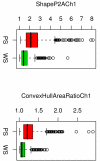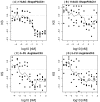Impact of image segmentation on high-content screening data quality for SK-BR-3 cells
- PMID: 17868449
- PMCID: PMC2080643
- DOI: 10.1186/1471-2105-8-340
Impact of image segmentation on high-content screening data quality for SK-BR-3 cells
Abstract
Background: High content screening (HCS) is a powerful method for the exploration of cellular signalling and morphology that is rapidly being adopted in cancer research. HCS uses automated microscopy to collect images of cultured cells. The images are subjected to segmentation algorithms to identify cellular structures and quantitate their morphology, for hundreds to millions of individual cells. However, image analysis may be imperfect, especially for "HCS-unfriendly" cell lines whose morphology is not well handled by current image segmentation algorithms. We asked if segmentation errors were common for a clinically relevant cell line, if such errors had measurable effects on the data, and if HCS data could be improved by automated identification of well-segmented cells.
Results: Cases of poor cell body segmentation occurred frequently for the SK-BR-3 cell line. We trained classifiers to identify SK-BR-3 cells that were well segmented. On an independent test set created by human review of cell images, our optimal support-vector machine classifier identified well-segmented cells with 81% accuracy. The dose responses of morphological features were measurably different in well- and poorly-segmented populations. Elimination of the poorly-segmented cell population increased the purity of DNA content distributions, while appropriately retaining biological heterogeneity, and simultaneously increasing our ability to resolve specific morphological changes in perturbed cells.
Conclusion: Image segmentation has a measurable impact on HCS data. The application of a multivariate shape-based filter to identify well-segmented cells improved HCS data quality for an HCS-unfriendly cell line, and could be a valuable post-processing step for some HCS datasets.
Figures









Similar articles
-
An automated feedback system with the hybrid model of scoring and classification for solving over-segmentation problems in RNAi high content screening.J Microsc. 2007 May;226(Pt 2):121-32. doi: 10.1111/j.1365-2818.2007.01762.x. J Microsc. 2007. PMID: 17444941
-
A computerized cellular imaging system for high content analysis in Monastrol suppressor screens.J Biomed Inform. 2006 Apr;39(2):115-25. doi: 10.1016/j.jbi.2005.05.008. Epub 2005 Jun 22. J Biomed Inform. 2006. PMID: 16011909
-
A fast, fully automated cell segmentation algorithm for high-throughput and high-content screening.Cytometry A. 2008 Oct;73(10):958-64. doi: 10.1002/cyto.a.20627. Cytometry A. 2008. PMID: 18752283
-
Automated image analysis for high-content screening and analysis.J Biomol Screen. 2010 Aug;15(7):726-34. doi: 10.1177/1087057110370894. Epub 2010 May 20. J Biomol Screen. 2010. PMID: 20488979 Review.
-
Computer vision for high content screening.Crit Rev Biochem Mol Biol. 2016;51(2):102-9. doi: 10.3109/10409238.2015.1135868. Epub 2016 Jan 24. Crit Rev Biochem Mol Biol. 2016. PMID: 26806341 Review.
Cited by
-
A novel measure and significance testing in data analysis of cell image segmentation.BMC Bioinformatics. 2017 Mar 14;18(1):168. doi: 10.1186/s12859-017-1527-x. BMC Bioinformatics. 2017. PMID: 28292256 Free PMC article.
-
NeuronAlg: An Innovative Neuronal Computational Model for Immunofluorescence Image Segmentation.Sensors (Basel). 2023 May 9;23(10):4598. doi: 10.3390/s23104598. Sensors (Basel). 2023. PMID: 37430509 Free PMC article.
-
Gebiss: an ImageJ plugin for the specification of ground truth and the performance evaluation of 3D segmentation algorithms.BMC Bioinformatics. 2011 Jun 13;12:232. doi: 10.1186/1471-2105-12-232. BMC Bioinformatics. 2011. PMID: 21668958 Free PMC article.
-
Semi-automated discrimination of retinal pigmented epithelial cells in two-photon fluorescence images of mouse retinas.Biomed Opt Express. 2015 Jul 23;6(8):3032-52. doi: 10.1364/BOE.6.003032. eCollection 2015 Aug 1. Biomed Opt Express. 2015. PMID: 26309765 Free PMC article.
-
Automatic segmentation and supervised learning-based selection of nuclei in cancer tissue images.Cytometry A. 2012 Sep;81(9):743-54. doi: 10.1002/cyto.a.22097. Epub 2012 Jul 31. Cytometry A. 2012. PMID: 22899462 Free PMC article.
References
-
- Bergman I, Barmada MA, Griffin JA, Slamon DJ. Treatment of meningeal breast cancer xenografts in the rat using an anti-p185/HER2 antibody. Clinical Cancer Research. 2001;7:2050–2056. - PubMed
-
- De Lorenzo C, Palmer DB, Piccoli R, Ritter MA, D'Alessio G. Clinical Cancer Research. Vol. 8. 2002; A new human antitumor immunoreagent specific for ErbB2; pp. 1710–1719. - PubMed
-
- Lee S, Yang W, Lan KH, Sellappan S, Klos K, Hortobagyi G, Hung MC, Yu D. Cancer Res. Vol. 62. 2002; Enhanced sensitization to taxol-induced apoptosis by herceptin pretreatment in ErbB2-overexpressing breast cancer cells; pp. 5703–5710. - PubMed
-
- Giuliano KA, DeBiasio RL, Dunlay RT, Gough A, Volosky JM, Zock J, Pavlakis GN, Taylor DL. High-Content Screening: A New Approach to Easing Key Bottlenecks in the Drug Discovery Process. J Biomol Screen. 1997;2:249–259. doi: 10.1177/108705719700200410. - DOI
MeSH terms
LinkOut - more resources
Full Text Sources
Other Literature Sources

